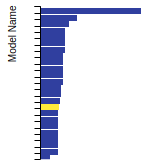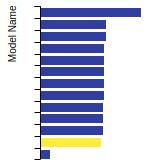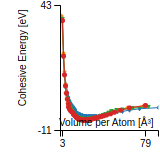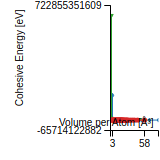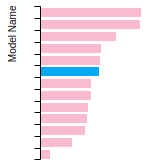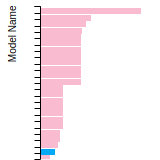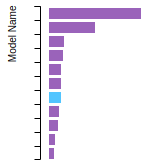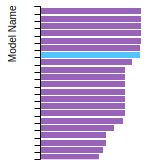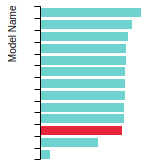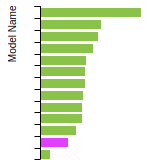Sim_LAMMPS_ADP_SmirnovaStarikov_2017_ZrNb__SM_937902197407_000
| Title
A single sentence description.
|
LAMMPS ADP potential for the Zr-Nb system developed by Smirnova and Starikov (2017) v000 |
|---|---|
| Description | We report a new attempt to study properties of Zr-Nb structural alloys. For this purpose we constructed an angular-dependent many-body interatomic potential. The potential functions were fitted towards the ab initio data computed for a large set of reference structures. The fitting procedure is described, and its accuracy is discussed. We show that the structure and properties of all Nb and Zr phases existing in the Zr-Nb binary system are reproduced with good accuracy. The interatomic potential is appropriate for study of the high-pressure hexagonal ω-phase of Zr. We also estimated characteristics of the point defects in α-Zr, β-Zr and Nb; results are proven to correlate with the existing experimental and theoretical data. In case of α-Zr the model reveals anisotropy of the vacancy diffusion, in agreement with previous calculations and experiments. The potential provides an opportunity for simulation of Zr-Nb alloys based on α-Zr and β-Zr. This conclusion is illustrated by the results obtained for the alloys with different niobium concentrations: up to 7% in case of hcp alloys and up to 50% for bcc alloys. |
| Species
The supported atomic species.
| Nb, Zr |
| Disclaimer
A statement of applicability provided by the contributor, informing users of the intended use of this KIM Item.
|
None |
| Content Origin | NIST IPRP (https://www.ctcms.nist.gov/potentials/Zr.html#Zr-Nb) |
| Contributor |
Ronald E. Miller |
| Maintainer |
Ronald E. Miller |
| Developer |
Daria Smirnova Sergey Starikov |
| Published on KIM | 2019 |
| How to Cite |
This Simulator Model originally published in [1] is archived in OpenKIM [2-4]. [1] Smirnova DE, Starikov SV. An interatomic potential for simulation of Zr-Nb system. Computational Materials Science [Internet]. 2017Mar;129:259–72. Available from: https://doi.org/10.1016/j.commatsci.2016.12.016 doi:10.1016/j.commatsci.2016.12.016 — (Primary Source) A primary source is a reference directly related to the item documenting its development, as opposed to other sources that are provided as background information. [2] Smirnova D, Starikov S. LAMMPS ADP potential for the Zr-Nb system developed by Smirnova and Starikov (2017) v000. OpenKIM; 2019. doi:10.25950/8f9857b3 [3] Tadmor EB, Elliott RS, Sethna JP, Miller RE, Becker CA. The potential of atomistic simulations and the Knowledgebase of Interatomic Models. JOM. 2011;63(7):17. doi:10.1007/s11837-011-0102-6 [4] Elliott RS, Tadmor EB. Knowledgebase of Interatomic Models (KIM) Application Programming Interface (API). OpenKIM; 2011. doi:10.25950/ff8f563a Click here to download the above citation in BibTeX format. |
| Citations
This panel presents information regarding the papers that have cited the interatomic potential (IP) whose page you are on. The OpenKIM machine learning based Deep Citation framework is used to determine whether the citing article actually used the IP in computations (denoted by "USED") or only provides it as a background citation (denoted by "NOT USED"). For more details on Deep Citation and how to work with this panel, click the documentation link at the top of the panel. The word cloud to the right is generated from the abstracts of IP principle source(s) (given below in "How to Cite") and the citing articles that were determined to have used the IP in order to provide users with a quick sense of the types of physical phenomena to which this IP is applied. The bar chart shows the number of articles that cited the IP per year. Each bar is divided into green (articles that USED the IP) and blue (articles that did NOT USE the IP). Users are encouraged to correct Deep Citation errors in determination by clicking the speech icon next to a citing article and providing updated information. This will be integrated into the next Deep Citation learning cycle, which occurs on a regular basis. OpenKIM acknowledges the support of the Allen Institute for AI through the Semantic Scholar project for providing citation information and full text of articles when available, which are used to train the Deep Citation ML algorithm. |
This panel provides information on past usage of this interatomic potential (IP) powered by the OpenKIM Deep Citation framework. The word cloud indicates typical applications of the potential. The bar chart shows citations per year of this IP (bars are divided into articles that used the IP (green) and those that did not (blue)). The complete list of articles that cited this IP is provided below along with the Deep Citation determination on usage. See the Deep Citation documentation for more information. 
33 Citations (27 used)
Help us to determine which of the papers that cite this potential actually used it to perform calculations. If you know, click the .
USED (definite) M. Basaadat and M. Payami, “Elastic stiffness tensors of Zr–xNb alloy in the presence of defects: A molecular dynamics study,” International Journal of Modern Physics C. 2019. link Times cited: 3 Abstract: In a nuclear reactor, the Zr–[Formula: see text]Nb alloy, wh… read more USED (high confidence) D. Singh and A. Parashar, “Atomistic simulations to study the effect of Nb precipitate on fracture properties of bi-crystalline Zr,” Journal of Physics D: Applied Physics. 2019. link Times cited: 7 Abstract: In this article, molecular dynamics based simulations were c… read more USED (high confidence) I. Gordeev and S. Starikov, “Comparison of Different Methods of Atomistic Simulation To Calculate the Temperature of Phase Transition Using the Example of Zirconium,” Journal of Experimental and Theoretical Physics. 2019. link Times cited: 5 USED (high confidence) E. Y. Chen, C. Deo, and R. Dingreville, “Irradiation resistance of nanostructured interfaces in Zr–Nb metallic multilayers,” Journal of Materials Research. 2019. link Times cited: 21 Abstract: Irradiation resistance of metallic nanostructured multilayer… read more USED (low confidence) M. M. Hasan, S. G. Srinivasan, and D. Choudhuri, “Transformation- and twinning-induced plasticity in phase-separated bcc Nb-Zr alloys: an atomistic study,” Journal of Materials Science. 2023. link Times cited: 0 USED (low confidence) M. Basaadat and S. Sheykhi, “Molecular Dynamics Study of Microstructural Evolution and Damage-Depth Induced by Isotropic Irradiation on Zr-1%Nb Alloy,” Journal of Nuclear Research and Applications. 2023. link Times cited: 0 Abstract: Zirconium alloys with niobium have extensive applications in… read more USED (low confidence) H. Mei et al., “Development of Machine Learning and Empirical Interatomic Potentials for the Binary Zr-Sn System,” Journal of Nuclear Materials. 2023. link Times cited: 0 USED (low confidence) D. D. Zuo, J. Chang, Q. Wang, and H. P. Wang, “Thermophysical properties and atomic structure of liquid Zr–Nb alloys investigated by electrostatic levitation and molecular dynamics simulation,” Journal of Physics: Condensed Matter. 2023. link Times cited: 0 Abstract: The investigation of the thermophysical properties of liquid… read more USED (low confidence) M. Basaadat, M. Payami, and S. Sheykhi, “Analysis of Irradiation Induced Defect Clusterization for Zr-1%Nb Alloy Using Atomistic Simulation,” Journal of Nuclear Research and Applications. 2023. link Times cited: 0 Abstract: Nuclear-grade zirconium alloys' properties are very sim… read more USED (low confidence) A. T. AlMotasem, N. Daghbouj, H. Sen, S. Mirzaei, M. Callisti, and T. Polcar, “Influence of HCP/BCC interface orientation on the tribological behavior of Zr/Nb multilayer during nanoscratch: A combined experimental and atomistic study,” Acta Materialia. 2023. link Times cited: 10 USED (low confidence) S. Liu, X. Liu, R. Xie, X. Feng, C. He, and J.-X. Liu, “Mechanism and influence factors on energy-release capacity under the high-velocity impact fragmentation of Zr-Nb alloys,” Journal of Alloys and Compounds. 2022. link Times cited: 1 USED (low confidence) C. Dai and N. Ofori-Opoku, “Deformation mechanism in the mechanical response of nano polycrystalline HCP Zr and Zr-2.5 Nb: an atomistic study,” Materials Today Communications. 2022. link Times cited: 0 USED (low confidence) V. Neaga, L. Benea, and E. R. Axente, “Corrosion Assessment of Zr2.5Nb Alloy in Ringer’s Solution by Electrochemical Methods,” Applied Sciences. 2022. link Times cited: 2 Abstract: This study aims to investigate the anticorrosive properties … read more USED (low confidence) M. Zhou, B. Fu, Q. Hou, L. Wu, and R. Pan, “Determining the diffusion behavior of point defects in zirconium by a multiscale modelling approach,” Journal of Nuclear Materials. 2022. link Times cited: 3 USED (low confidence) S. Kumar and V. Jindal, “Thermodynamic Re-assessment of the Nb-Zr System Using the CE–CVM Model for Solid Solution Phases,” Journal of Phase Equilibria and Diffusion. 2022. link Times cited: 0 USED (low confidence) N. Daghbouj et al., “Revealing Nanoscale Strain Mechanisms in Ion-Irradiated Multilayers,” Acta Materialia. 2022. link Times cited: 25 Abstract: Tailoring of interfaces is a powerful way of reducing the ac… read more USED (low confidence) S. S. Kliavinek and L. Kolotova, “Modeling of glass transition process and elastic properties of Zr-Nb amorphous alloys,” Journal of Non-crystalline Solids. 2021. link Times cited: 1 USED (low confidence) V. Maksimenko, A. Lipnitskii, V. Saveliev, I. Nelasov, and A. Kartamyshev, “Prediction of the diffusion characteristics of the V-Cr system by molecular dynamics based on N-body interatomic potentials,” Computational Materials Science. 2021. link Times cited: 5 USED (low confidence) S. Starikov and D. Smirnova, “Optimized interatomic potential for atomistic simulation of Zr-Nb alloy,” Computational Materials Science. 2021. link Times cited: 15 USED (low confidence) B. Lin, J. Li, Z. Wang, and J. Wang, “Dislocation nucleation from Zr–Nb bimetal interfaces cooperating with the dynamic evolution of interfacial dislocations,” International Journal of Plasticity. 2020. link Times cited: 13 USED (low confidence) X.-long An, H. Zhang, S. Ni, X. Ou, X. Liao, and M. Song, “Effects of temperature and alloying content on the phase transformation and 101¯1 twinning in Zr during rolling,” Journal of Materials Science & Technology. 2020. link Times cited: 19 USED (low confidence) D. Singh, A. Parashar, and R. Kapoor, “Effect of Nb precipitate on defect formation and migration energies in bi-crystalline Zr,” Materials Chemistry and Physics. 2019. link Times cited: 4 USED (low confidence) K. V. Reddy and S. Pal, “Evaluation of glass forming ability of Zr–Nb alloy systems through liquid fragility and Voronoi cluster analysis,” Computational Materials Science. 2019. link Times cited: 14 USED (low confidence) D. Smirnova, S. Starikov, and A. Vlasova, “New interatomic potential for simulation of pure magnesium and magnesium hydrides,” Computational Materials Science. 2018. link Times cited: 17 USED (low confidence) D. Smirnova, S. Starikov, and I. Gordeev, “Evaluation of the structure and properties for the high-temperature phase of zirconium from the atomistic simulations,” Computational Materials Science. 2018. link Times cited: 13 USED (low confidence) S. Starikov, N. Lopanitsyna, D. Smirnova, and S. Makarov, “Atomistic simulation of Si-Au melt crystallization with novel interatomic potential,” Computational Materials Science. 2018. link Times cited: 20 USED (low confidence) D. Smirnova and S. Starikov, “Study of Niobium Diffusion and Clusterization in hcp Zr-Nb Dilute Alloys,” Defect and Diffusion Forum. 2017. link Times cited: 3 Abstract: We perform atomistic simulations aimed on study of diffusion… read more NOT USED (high confidence) O. G. Nicholls, D. Frost, V. Tuli, J. Smutná, M. Wenman, and P. Burr, “Transferability of Zr-Zr interatomic potentials,” Journal of Nuclear Materials. 2022. link Times cited: 6 NOT USED (high confidence) W. Muftah, J. Allport, and V. Vishnyakov, “Corrosion performance and mechanical properties of FeCrSiNb amorphous equiatomic HEA thin film,” Surface & Coatings Technology. 2021. link Times cited: 17 NOT USED (high confidence) B. Lin, J. Wang, J. Li, and Z. Wang, “A neural-network based framework of developing cross interaction in alloy embedded-atom method potentials: application to Zr–Nb alloy,” Journal of Physics: Condensed Matter. 2020. link Times cited: 2 Abstract: Interaction potentials are critical to molecular dynamics si… read more NOT USED (high confidence) S. S. Kliavinek and L. Kolotova, “Molecular Dynamics Simulation of Glass Transition of the Supercooled Zr–Nb Melt,” Journal of Experimental and Theoretical Physics. 2020. link Times cited: 4 NOT USED (high confidence) W. Setyawan, N. Gao, and R. Kurtz, “A tungsten-rhenium interatomic potential for point defect studies,” Journal of Applied Physics. 2018. link Times cited: 22 Abstract: A tungsten-rhenium (W-Re) classical interatomic potential is… read more NOT USED (high confidence) H. Wang et al., “Effects of Nb concentration and temperature on generalized stacking fault energy of Zr–Nb alloys by molecular dynamics simulations,” Materials Research Express. 2021. link Times cited: 0 Abstract: The effects of Nb concentration and temperature on the gener… read more |
| Funding | Not available |
| Short KIM ID
The unique KIM identifier code.
| SM_937902197407_000 |
| Extended KIM ID
The long form of the KIM ID including a human readable prefix (100 characters max), two underscores, and the Short KIM ID. Extended KIM IDs can only contain alpha-numeric characters (letters and digits) and underscores and must begin with a letter.
| Sim_LAMMPS_ADP_SmirnovaStarikov_2017_ZrNb__SM_937902197407_000 |
| DOI |
10.25950/8f9857b3 https://doi.org/10.25950/8f9857b3 https://commons.datacite.org/doi.org/10.25950/8f9857b3 |
| KIM Item Type | Simulator Model |
| KIM API Version | 2.1 |
| Simulator Name
The name of the simulator as defined in kimspec.edn.
| LAMMPS |
| Potential Type | adp |
| Simulator Potential | adp |
| Run Compatibility | portable-models |
| Programming Language(s)
The programming languages used in the code and the percentage of the code written in each one.
| 100.00% Tcl |
| Grade | Name | Category | Brief Description | Full Results | Aux File(s) |
|---|---|---|---|---|---|
| P | vc-species-supported-as-stated | mandatory | The model supports all species it claims to support; see full description. |
Results | Files |
| P | vc-periodicity-support | mandatory | Periodic boundary conditions are handled correctly; see full description. |
Results | Files |
| P | vc-permutation-symmetry | mandatory | Total energy and forces are unchanged when swapping atoms of the same species; see full description. |
Results | Files |
| B | vc-forces-numerical-derivative | consistency | Forces computed by the model agree with numerical derivatives of the energy; see full description. |
Results | Files |
| F | vc-dimer-continuity-c1 | informational | The energy versus separation relation of a pair of atoms is C1 continuous (i.e. the function and its first derivative are continuous); see full description. |
Results | Files |
| P | vc-objectivity | informational | Total energy is unchanged and forces transform correctly under rigid-body translation and rotation; see full description. |
Results | Files |
| P | vc-inversion-symmetry | informational | Total energy is unchanged and forces change sign when inverting a configuration through the origin; see full description. |
Results | Files |
| F | vc-memory-leak | informational | The model code does not have memory leaks (i.e. it releases all allocated memory at the end); see full description. |
Results | Files |
| N/A | vc-thread-safe | mandatory | The model returns the same energy and forces when computed in serial and when using parallel threads for a set of configurations. Note that this is not a guarantee of thread safety; see full description. |
Results | Files |
BCC Lattice Constant
This bar chart plot shows the mono-atomic body-centered cubic (bcc) lattice constant predicted by the current model (shown in the unique color) compared with the predictions for all other models in the OpenKIM Repository that support the species. The vertical bars show the average and standard deviation (one sigma) bounds for all model predictions. Graphs are generated for each species supported by the model.
Cohesive Energy Graph
This graph shows the cohesive energy versus volume-per-atom for the current mode for four mono-atomic cubic phases (body-centered cubic (bcc), face-centered cubic (fcc), simple cubic (sc), and diamond). The curve with the lowest minimum is the ground state of the crystal if stable. (The crystal structure is enforced in these calculations, so the phase may not be stable.) Graphs are generated for each species supported by the model.
Diamond Lattice Constant
This bar chart plot shows the mono-atomic face-centered diamond lattice constant predicted by the current model (shown in the unique color) compared with the predictions for all other models in the OpenKIM Repository that support the species. The vertical bars show the average and standard deviation (one sigma) bounds for all model predictions. Graphs are generated for each species supported by the model.
Dislocation Core Energies
This graph shows the dislocation core energy of a cubic crystal at zero temperature and pressure for a specific set of dislocation core cutoff radii. After obtaining the total energy of the system from conjugate gradient minimizations, non-singular, isotropic and anisotropic elasticity are applied to obtain the dislocation core energy for each of these supercells with different dipole distances. Graphs are generated for each species supported by the model.
(No matching species)FCC Elastic Constants
This bar chart plot shows the mono-atomic face-centered cubic (fcc) elastic constants predicted by the current model (shown in blue) compared with the predictions for all other models in the OpenKIM Repository that support the species. The vertical bars show the average and standard deviation (one sigma) bounds for all model predictions. Graphs are generated for each species supported by the model.
FCC Lattice Constant
This bar chart plot shows the mono-atomic face-centered cubic (fcc) lattice constant predicted by the current model (shown in red) compared with the predictions for all other models in the OpenKIM Repository that support the species. The vertical bars show the average and standard deviation (one sigma) bounds for all model predictions. Graphs are generated for each species supported by the model.
FCC Stacking Fault Energies
This bar chart plot shows the intrinsic and extrinsic stacking fault energies as well as the unstable stacking and unstable twinning energies for face-centered cubic (fcc) predicted by the current model (shown in blue) compared with the predictions for all other models in the OpenKIM Repository that support the species. The vertical bars show the average and standard deviation (one sigma) bounds for all model predictions. Graphs are generated for each species supported by the model.
(No matching species)FCC Surface Energies
This bar chart plot shows the mono-atomic face-centered cubic (fcc) relaxed surface energies predicted by the current model (shown in blue) compared with the predictions for all other models in the OpenKIM Repository that support the species. The vertical bars show the average and standard deviation (one sigma) bounds for all model predictions. Graphs are generated for each species supported by the model.
(No matching species)SC Lattice Constant
This bar chart plot shows the mono-atomic simple cubic (sc) lattice constant predicted by the current model (shown in the unique color) compared with the predictions for all other models in the OpenKIM Repository that support the species. The vertical bars show the average and standard deviation (one sigma) bounds for all model predictions. Graphs are generated for each species supported by the model.
Cubic Crystal Basic Properties Table
Species: NbSpecies: Zr
Creators:
Contributor: karls
Publication Year: 2019
DOI: https://doi.org/10.25950/64cb38c5
This Test Driver uses LAMMPS to compute the cohesive energy of a given monoatomic cubic lattice (fcc, bcc, sc, or diamond) at a variety of lattice spacings. The lattice spacings range from a_min (=a_min_frac*a_0) to a_max (=a_max_frac*a_0) where a_0, a_min_frac, and a_max_frac are read from stdin (a_0 is typically approximately equal to the equilibrium lattice constant). The precise scaling and number of lattice spacings sampled between a_min and a_0 (a_0 and a_max) is specified by two additional parameters passed from stdin: N_lower and samplespacing_lower (N_upper and samplespacing_upper). Please see README.txt for further details.
| Test | Test Results | Link to Test Results page | Benchmark time
Usertime multiplied by the Whetstone Benchmark. This number can be used (approximately) to compare the performance of different models independently of the architecture on which the test was run.
Measured in Millions of Whetstone Instructions (MWI) |
|---|---|---|---|
| Cohesive energy versus lattice constant curve for bcc Nb v004 | view | 3720 | |
| Cohesive energy versus lattice constant curve for bcc Zr v004 | view | 3899 | |
| Cohesive energy versus lattice constant curve for diamond Nb v004 | view | 4564 | |
| Cohesive energy versus lattice constant curve for diamond Zr v004 | view | 4491 | |
| Cohesive energy versus lattice constant curve for fcc Nb v004 | view | 4417 | |
| Cohesive energy versus lattice constant curve for fcc Zr v004 | view | 4417 | |
| Cohesive energy versus lattice constant curve for sc Nb v004 | view | 4417 | |
| Cohesive energy versus lattice constant curve for sc Zr v004 | view | 3610 |
Creators: Junhao Li and Ellad Tadmor
Contributor: tadmor
Publication Year: 2019
DOI: https://doi.org/10.25950/5853fb8f
Computes the cubic elastic constants for some common crystal types (fcc, bcc, sc, diamond) by calculating the hessian of the energy density with respect to strain. An estimate of the error associated with the numerical differentiation performed is reported.
| Test | Test Results | Link to Test Results page | Benchmark time
Usertime multiplied by the Whetstone Benchmark. This number can be used (approximately) to compare the performance of different models independently of the architecture on which the test was run.
Measured in Millions of Whetstone Instructions (MWI) |
|---|---|---|---|
| Elastic constants for bcc Nb at zero temperature v006 | view | 2399 | |
| Elastic constants for bcc Zr at zero temperature v006 | view | 7773 | |
| Elastic constants for diamond Nb at zero temperature v001 | view | 31957 | |
| Elastic constants for diamond Zr at zero temperature v001 | view | 15195 | |
| Elastic constants for fcc Nb at zero temperature v006 | view | 8189 | |
| Elastic constants for fcc Zr at zero temperature v006 | view | 5662 | |
| Elastic constants for sc Nb at zero temperature v006 | view | 2399 | |
| Elastic constants for sc Zr at zero temperature v006 | view | 2527 |
Creators: Junhao Li
Contributor: jl2922
Publication Year: 2019
DOI: https://doi.org/10.25950/d794c746
Computes the elastic constants for hcp crystals by calculating the hessian of the energy density with respect to strain. An estimate of the error associated with the numerical differentiation performed is reported.
| Test | Test Results | Link to Test Results page | Benchmark time
Usertime multiplied by the Whetstone Benchmark. This number can be used (approximately) to compare the performance of different models independently of the architecture on which the test was run.
Measured in Millions of Whetstone Instructions (MWI) |
|---|---|---|---|
| Elastic constants for hcp Nb at zero temperature v004 | view | 1846 | |
| Elastic constants for hcp Zr at zero temperature v004 | view | 2356 |
Creators:
Contributor: ilia
Publication Year: 2025
DOI: https://doi.org/10.25950/866c7cfa
Computes the equilibrium crystal structure and energy for an arbitrary crystal at zero temperature and applied stress by performing symmetry-constrained relaxation. The crystal structure is specified using the AFLOW prototype designation. Multiple sets of free parameters corresponding to the crystal prototype may be specified as initial guesses for structure optimization. No guarantee is made regarding the stability of computed equilibria, nor that any are the ground state.
| Test | Test Results | Link to Test Results page | Benchmark time
Usertime multiplied by the Whetstone Benchmark. This number can be used (approximately) to compare the performance of different models independently of the architecture on which the test was run.
Measured in Millions of Whetstone Instructions (MWI) |
|---|---|---|---|
| Equilibrium crystal structure and energy for Nb in AFLOW crystal prototype A_cF4_225_a v003 | view | 215789 | |
| Equilibrium crystal structure and energy for Zr in AFLOW crystal prototype A_cF4_225_a v003 | view | 207382 | |
| Equilibrium crystal structure and energy for Nb in AFLOW crystal prototype A_cI2_229_a v003 | view | 174073 | |
| Equilibrium crystal structure and energy for Zr in AFLOW crystal prototype A_cI2_229_a v003 | view | 137561 | |
| Equilibrium crystal structure and energy for Zr in AFLOW crystal prototype A_hP2_194_c v003 | view | 184562 |
Creators: Daniel S. Karls and Junhao Li
Contributor: karls
Publication Year: 2019
DOI: https://doi.org/10.25950/2765e3bf
Equilibrium lattice constant and cohesive energy of a cubic lattice at zero temperature and pressure.
| Test | Test Results | Link to Test Results page | Benchmark time
Usertime multiplied by the Whetstone Benchmark. This number can be used (approximately) to compare the performance of different models independently of the architecture on which the test was run.
Measured in Millions of Whetstone Instructions (MWI) |
|---|---|---|---|
| Equilibrium zero-temperature lattice constant for bcc Nb v007 | view | 5566 | |
| Equilibrium zero-temperature lattice constant for bcc Zr v007 | view | 6846 | |
| Equilibrium zero-temperature lattice constant for diamond Nb v007 | view | 8733 | |
| Equilibrium zero-temperature lattice constant for diamond Zr v007 | view | 9917 | |
| Equilibrium zero-temperature lattice constant for fcc Nb v007 | view | 11004 | |
| Equilibrium zero-temperature lattice constant for fcc Zr v007 | view | 6558 | |
| Equilibrium zero-temperature lattice constant for sc Nb v007 | view | 6302 | |
| Equilibrium zero-temperature lattice constant for sc Zr v007 | view | 5854 |
Creators: Daniel S. Karls and Junhao Li
Contributor: karls
Publication Year: 2019
DOI: https://doi.org/10.25950/c339ca32
Calculates lattice constant of hexagonal bulk structures at zero temperature and pressure by using simplex minimization to minimize the potential energy.
| Test | Test Results | Link to Test Results page | Benchmark time
Usertime multiplied by the Whetstone Benchmark. This number can be used (approximately) to compare the performance of different models independently of the architecture on which the test was run.
Measured in Millions of Whetstone Instructions (MWI) |
|---|---|---|---|
| Equilibrium lattice constants for hcp Nb v005 | view | 48072 | |
| Equilibrium lattice constants for hcp Zr v005 | view | 38522 |
Creators: Matt Bierbaum
Contributor: mattbierbaum
Publication Year: 2019
DOI: https://doi.org/10.25950/6c43a4e6
Calculates the surface energy of several high symmetry surfaces and produces a broken-bond model fit. In latex form, the fit equations are given by:
E_{FCC} (\vec{n}) = p_1 (4 \left( |x+y| + |x-y| + |x+z| + |x-z| + |z+y| +|z-y|\right)) + p_2 (8 \left( |x| + |y| + |z|\right)) + p_3 (2 ( |x+ 2y + z| + |x+2y-z| + |x-2y + z| + |x-2y-z| + |2x+y+z| + |2x+y-z| +|2x-y+z| +|2x-y-z| +|x+y+2z| +|x+y-2z| +|x-y+2z| +|x-y-2z| ) + c
E_{BCC} (\vec{n}) = p_1 (6 \left( | x+y+z| + |x+y-z| + |-x+y-z| + |x-y+z| \right)) + p_2 (8 \left( |x| + |y| + |z|\right)) + p_3 (4 \left( |x+y| + |x-y| + |x+z| + |x-z| + |z+y| +|z-y|\right)) +c.
In Python, these two fits take the following form:
def BrokenBondFCC(params, index):
import numpy
x, y, z = index
x = x / numpy.sqrt(x**2.+y**2.+z**2.)
y = y / numpy.sqrt(x**2.+y**2.+z**2.)
z = z / numpy.sqrt(x**2.+y**2.+z**2.)
return params[0]*4* (abs(x+y) + abs(x-y) + abs(x+z) + abs(x-z) + abs(z+y) + abs(z-y)) + params[1]*8*(abs(x) + abs(y) + abs(z)) + params[2]*(abs(x+2*y+z) + abs(x+2*y-z) +abs(x-2*y+z) +abs(x-2*y-z) + abs(2*x+y+z) +abs(2*x+y-z) +abs(2*x-y+z) +abs(2*x-y-z) + abs(x+y+2*z) +abs(x+y-2*z) +abs(x-y+2*z) +abs(x-y-2*z))+params[3]
def BrokenBondBCC(params, x, y, z):
import numpy
x, y, z = index
x = x / numpy.sqrt(x**2.+y**2.+z**2.)
y = y / numpy.sqrt(x**2.+y**2.+z**2.)
z = z / numpy.sqrt(x**2.+y**2.+z**2.)
return params[0]*6*(abs(x+y+z) + abs(x-y-z) + abs(x-y+z) + abs(x+y-z)) + params[1]*8*(abs(x) + abs(y) + abs(z)) + params[2]*4* (abs(x+y) + abs(x-y) + abs(x+z) + abs(x-z) + abs(z+y) + abs(z-y)) + params[3]
| Test | Test Results | Link to Test Results page | Benchmark time
Usertime multiplied by the Whetstone Benchmark. This number can be used (approximately) to compare the performance of different models independently of the architecture on which the test was run.
Measured in Millions of Whetstone Instructions (MWI) |
|---|---|---|---|
| Broken-bond fit of high-symmetry surface energies in bcc Nb v004 | view | 74055 |
Creators:
Contributor: efuem
Publication Year: 2023
DOI: https://doi.org/10.25950/fca89cea
Computes the monovacancy formation energy and relaxation volume for cubic and hcp monoatomic crystals.
| Test | Test Results | Link to Test Results page | Benchmark time
Usertime multiplied by the Whetstone Benchmark. This number can be used (approximately) to compare the performance of different models independently of the architecture on which the test was run.
Measured in Millions of Whetstone Instructions (MWI) |
|---|---|---|---|
| Monovacancy formation energy and relaxation volume for bcc Nb | view | 7063004 | |
| Monovacancy formation energy and relaxation volume for hcp Zr | view | 6072219 |
Creators:
Contributor: efuem
Publication Year: 2023
DOI: https://doi.org/10.25950/c27ba3cd
Computes the monovacancy formation and migration energies for cubic and hcp monoatomic crystals.
| Test | Test Results | Link to Test Results page | Benchmark time
Usertime multiplied by the Whetstone Benchmark. This number can be used (approximately) to compare the performance of different models independently of the architecture on which the test was run.
Measured in Millions of Whetstone Instructions (MWI) |
|---|---|---|---|
| Vacancy formation and migration energy for bcc Nb | view | 13132646 | |
| Vacancy formation and migration energy for hcp Zr | view | 10496516 |
| Test | Error Categories | Link to Error page |
|---|---|---|
| Equilibrium crystal structure and energy for Zr in AFLOW crystal prototype A_hP2_194_c v000 | other | view |
| Sim_LAMMPS_ADP_SmirnovaStarikov_2017_ZrNb__SM_937902197407_000.txz | Tar+XZ | Linux and OS X archive |
| Sim_LAMMPS_ADP_SmirnovaStarikov_2017_ZrNb__SM_937902197407_000.zip | Zip | Windows archive |
